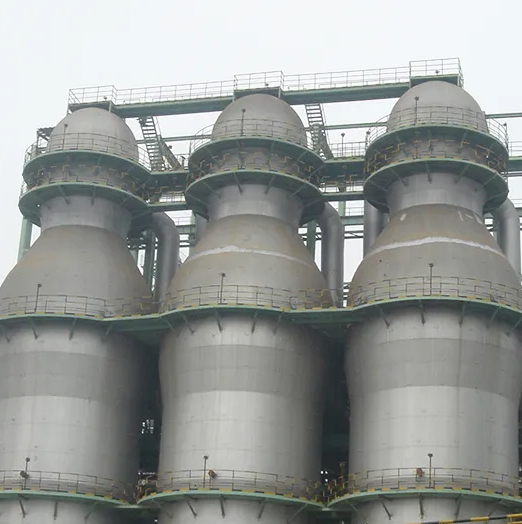1.Product introduction
Hot blast stove, is thermal power machinery, it has become a substitute for electric heat source and traditional steam-powered heat source in many industries. Hot blast furnace varieties, series of full, to add coal is divided into hand-fired, machine-fired two, to fuel type is divided into coal, oil, gas furnace, etc..
Blast furnace hot blast furnace is a heat storage exchanger, in order to meet the high temperature heat source of the hot blast furnace, the use of long time and other requirements, hot blast furnace with refractory materials should have high temperature resistance and high pressure, good creep resistance, large specific heat capacity, good thermal conductivity and other characteristics.
2. Application scope
1. Chemical and pharmaceutical industry chemicals, chemical products and pharmaceuticals preparation and drying
2. Textile printing and dyeing and non-woven industry Heat setting, hot melt dyeing, baking, hot air stentering
3. Foundry industry sand and sand core drying
4. Abrasives, abrasives industry sand cloth drying
5. Building materials industry wood drying, artificial board, laminate drying, gypsum board drying, glass fiber products drying
6. Agricultural products, feed and food processing baking coffee, tea, tobacco and vegetables, cereals, noodles, aquatic products, fish meal, soybean meal and other drying
7. Heating engineering industrial plants and civil building heating
8. Insulation materials, glass fiber reinforced plastic industry aluminum silicate fiber products, rare earth insulation, drying of glass fiber reinforced plastic products
3. Refractories for hot blast furnace
1. Refractories for the top part of the furnace.
The top part of the furnace is in the hot blast furnace internal high temperature area, here refractory materials should be selected thermal shock resistance, creep resistance refractory materials, generally can use silica bricks, clay bricks / high alumina bricks, high alumina heat insulation bricks, mullite bricks, lightweight clay bricks, acid-resistant spray coating, clay spray coating, etc.
2. Refractory materials for large wall of heat storage chamber.
The big wall of the heat storage room is the big wall of the hot blast furnace body, where the upper temperature is high and the middle and lower wind temperature is relatively low, the big wall of the heat storage room can use silicon bricks, high alumina bricks, high alumina heat insulation bricks, mullite bricks, light clay bricks, acid-resistant spray coating, light spray coating, etc.
The middle part can use high alumina brick, mullite brick, light weight clay brick, clay spray coating, light weight spray coating, etc.
The lower part can use clay brick, high alumina brick, light clay brick, high alumina heat insulation brick, clay casting material, light spray coating, heat resistant concrete, etc.
3. Refractory materials for lattice brick parts.
The upper part of the lattice brick generally uses silicon lattice brick, high alumina lattice brick, the middle part uses high alumina lattice brick, high alumina lattice brick, the lower part uses high alumina lattice brick, clay lattice brick.
In addition ball type hot blast furnace heat storage room generally use refractory ball to replace the lattice brick, the most common for high alumina refractory ball, low temperature area can use clay refractory ball.
4. Partition wall parts refractory materials.
Partition wall is a refractory brick wall separating the heat storage room and combustion chamber, the upper part of the partition wall refractory materials can be used silicon bricks, high alumina bricks.
The middle part can use high alumina brick, high alumina heat insulation brick, heat shock parts can use high alumina brick, high alumina heat insulation brick.
The lower part can use clay bricks, light clay bricks.
5. Combustion chamber big wall refractory materials.
Combustion chamber big wall and heat storage room refractory material configuration is basically the same, the upper part can use silicon bricks, high alumina bricks, high alumina heat insulation bricks, light silicon bricks, light clay bricks, spray coating, etc.
The middle part can use high alumina brick, high alumina brick, high alumina heat insulation brick, light clay brick, spray coating, etc.
The lower part can use clay brick, high alumina brick, light clay brick, spray coating, heat-resistant concrete, etc.
6. Burner nozzles.
Burner nozzle requires good linear expansion coefficient and creep resistance of refractory materials, so burner nozzle can use mullite material, high alumina castable prefabricated parts, etc.
7. Other parts of the hot air furnace refractory materials.
(1) hot air pipe with refractory materials, generally made of lightweight clay brick masonry, hot air outlet and the total air duct interface parts can use high alumina bricks, mullite bricks for masonry. Hot blast furnace around the pipe and air supply branch pipe can use high alumina cement refractory castable material, phosphate refractory castable material made of the whole pouring.
(2) hot air valve with refractory materials, generally use clay bricks, high alumina bricks for masonry life in 6 ~ 10 months, the use of high alumina cement refractory castables casting molding life of up to 1.5 years or so.
(3) flue and chimney parts refractory materials, can use clay bricks for masonry, chimney using concrete pouring, the lower part of the clay bricks as a protective layer.
5. Construction requirements
(1)Hot blast furnace shell installation in place, welding is completed and the weld inspection is qualified, and acceptance is completed
(2) Grate column, grate installation is completed, and check to confirm that it meets the design construction requirements
(3) flue outlet, hot air outlet, gas outlet, air outlet, temperature measurement, pressure measurement holes and manhole short pipe welding is completed, and to confirm the quality of qualified and acceptance completed
(4) hot blast furnace body centerline, elevation, measurement marks and control points, such as pull line markings accurate and clear
(5) Anchor installation, welding is completed and quality inspection is qualified and acceptance is completed
(6) The quantity, quality and material of refractory materials are inspected and stored properly and orderly after entering the site
(7) The use of various engineering equipment, appliances, etc. test run qualified and into position

